Selection of a circulation pump for heating: how to choose the right unit?
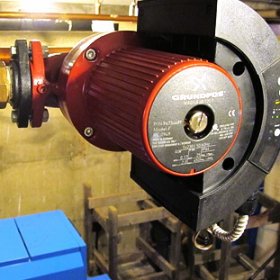
It is possible to increase the efficiency and reliability of autonomous heating systems used for heating private houses by installing special pumping equipment. A circulation pump for heating embedded in the pipeline helps to accelerate the movement of the coolant in the system, which ensures quick heating of all rooms in the house.
In large country cottages, whose living area exceeds one hundred square meters, the installation of such pumping equipment is indispensable. By adjusting the power of the built-in pump, the owner of the house can actively influence the operation of the heating system depending on weather conditions. Properly selected equipment allows you to save energy, avoiding its unreasonable cost overruns.
This video shows the Grundfos Alpha2 circulation pump device, in the design of which the manufacturer used energy-saving technologies. The authors of the video note a number of advantages of this model over other similar products. In addition, the video shows how to install this pump, which may help you get a general idea of the upcoming work.
Content
Types of circulation pumps and their device
The housing of any circulation pump for heating is made of stainless metal or alloy. The case may be steel, cast iron, aluminum, brass or bronze. Inside the case there is a steel or ceramic rotor, on the shaft of which an impeller-impeller is mounted. The equipment is powered by a single-phase or three-phase electric motor. Depending on whether the rotor is in contact with water or not, it is customary to divide the pumps into “wet” and “dry”.
Wet Rotor Pumps
"Wet" The circulation pump is characterized by the fact that its impeller and rotor interact with the coolant (hot water). In this case, water lubricates and cools the moving parts of the device. The rotor and stator of the circulation pump of this type separate the walls of the metal cup. As a result, such a constructive solution provides a sealed arrangement of a stator of an electrically powered motor.
Wet-type pumping equipment can be operated for a long time without any maintenance. Repairing these products, as well as setting up, is not particularly difficult. The devices are compact, lightweight, energy-efficient, noiseless, which allows you to mount them directly in the house. The design of wet rotor circulation pumps provides threaded or flange connections to facilitate the installation of products in the home heating system.
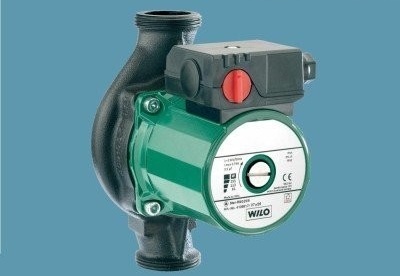
This is the model of the circulation pump for the water heating system of a private house or cottage. Pump rotor contacts coolant
The pump is installed in the heating system in such a way that the axis of its shaft is necessarily located in a strictly horizontal plane. It is this arrangement that will allow the coolant to continuously wash the bearings, while ensuring their lubrication. If this requirement is ignored, a pump breakdown is likely due to increased wear of moving parts due to a lack of lubricant.
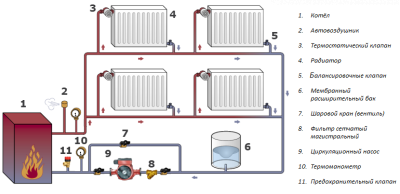
One of the possible schemes for connecting a wet-type circulation pump to the heating system of a country house with forced circulation of the coolant
The main disadvantage of “wet” pumps lies in the low value of efficiency, which is only 50%. This fact must be taken into account when choosing, since it makes sense to install this equipment only in water heating systems having a small pipeline length. Such models are recommended to be used to ensure forced circulation of the coolant in the heating system of a small private house.
Dry Rotor Pumps
The design of the “dry” circulation pump is designed so that the rotor of the device does not come into contact with water circulating through the pipes. The working part and the electric motor of the pump of this type are hermetically separated from each other by special seals. There are three subspecies of dry rotor circulation pumps:
- block;
- vertical
- horizontal (cantilever).
Pumping equipment of this type is characterized by high efficiency, reaching 80%, as well as increased noise level. therefore installation of a circulation pump The “dry” type is recommended to be carried out in a separate utility room, with particular attention to its sound insulation.
You will also find useful material on how to correctly calculate the required pump capacity for heating:https://aquatech.tomathouse.com/en/otoplenie/raschety/raschet-nasosa-dlya-otopleniya.html
How to choose the right pump model?
It should be remembered that the selection of the circulation pump is based on the hydraulic parameters of the heating system designed for a particular residential facility. Ensuring a comfortable microclimate in the house is possible when performing a competent calculation of the required amount of heat, which is produced by specialists taking into account the following criteria:
- the presence of special weather conditions in the region;
- thermal conductivity of the material used to erect the walls of the house, and the method of their insulation;
- orientation of the house to the cardinal points;
- the device of floors and floors of the house;
- characteristics of windows installed in the room;
- the presence of thermostatic valves in the system, etc.
As a result of the calculations, the amount of coolant supply in the water heating system is determined, measured in cubic meters per hour. This value is taken as the basis when choosing the right equipment. In addition, attention should be paid to the pump head, the quantitative value of which is calculated by the total hydraulic resistance in the system. You should not choose a pump with a “reserve” of power, as this will entail its operation “idle” for a long time during operation. Not only will the equipment work in vain, but also an electric meter will wind extra kilowatt hours.
If the reconstruction of the existing heating system is carried out, it is recommended to choose a special model of an adjustable circulation pump. In the production of this equipment, technologies are used that allow the devices to automatically respond to changing operating conditions of the heating system, adjusting to them.
How to install equipment?
When installing the pumping equipment in the heating system, designed for forced circulation of the coolant, the pump is inserted into the pipeline in a pre-selected section. In this case, the strapping of the circulation pump consists of the following elements:
- two stopcocks, which are located on both sides of the device;
- coarse filter;
- non-return valve used in closed systems that are equipped with a pneumatic storage tank.
If installation is carried out in a heating system, which provides for the use of natural and forced circulation of the coolant, then to the above parts still bypass added (pipe installed parallel to the pump and allowing to let the coolant bypass the pump). In order to switch the system to natural circulation, the bypass closes a valve designed specifically for this purpose.
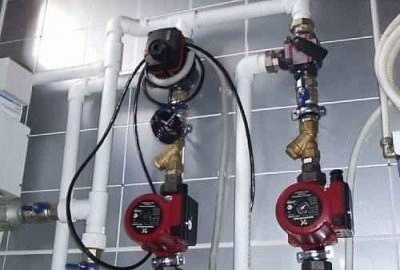
For intensive heating of large buildings, including two-story cottages, it is necessary to install a circulation pump in the installed heating system of the facility
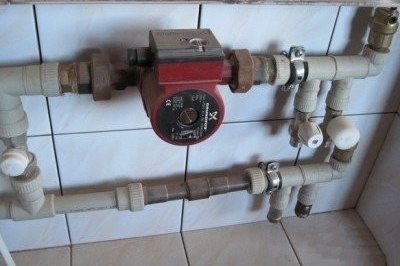
In the heating system of a private house, designed for natural and forced circulation of the coolant, the pump is installed on bypass
You can read more about the installation process in the article: Installing a pump in a heating system: an analysis of the basic installation rules and tricks.
The installation of heating systems in private homes and the installation of pumping equipment should be carried out by specialized companies that have competent specialists in their staffs. Professionals who know how to install such a pump, and more than once performing this operation, will perform all the work efficiently and give a guarantee. In addition, they can advise how to choose a specific model for the heating system of your home.
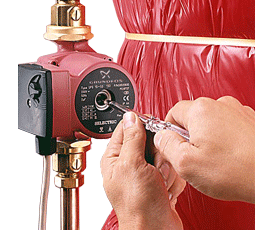
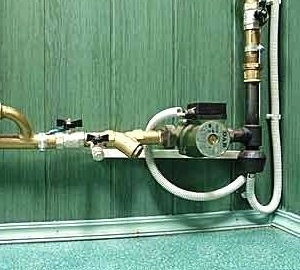
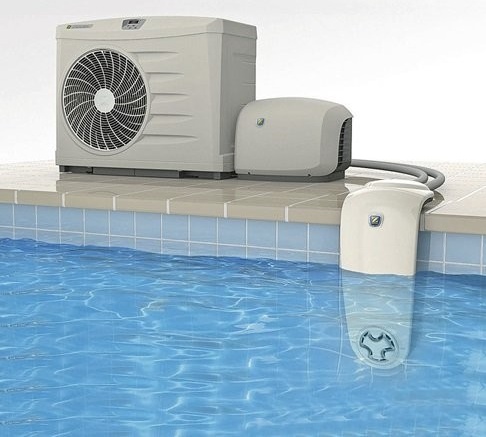
2 comments